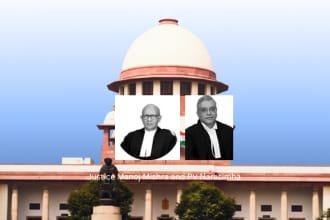In a landmark judgment reinforcing environmental safeguards, the Supreme Court of India has held that a valid and subsisting District Survey Report (DSR) is a mandatory requirement for Environmental Clearance (EC) in sand mining projects. The Court struck down the Uttar Pradesh Government’s e-auction of sand mining leases for relying on a lapsed DSR from 2017 and a draft DSR from 2023 that had not been finalized.
This ruling is a major reaffirmation of the precautionary and sustainable development principles under the Environment Protection Act, 1986 and the EIA Notification, 2006, as amended in 2016.
Background: Sand Mining & the Role of DSR
Sand mining, especially involving minor minerals under Category B2 projects, requires EC under the Environment Impact Assessment (EIA) framework. A District Survey Report (DSR) is a scientific, environmental, and geographical assessment of mineral resources in a district. It ensures sustainable mining practices while assessing the ecological impact.
The 2016 amendment to the EIA Notification made it mandatory for EC applications for Category B2 projects (like sand mining) to be backed by a valid DSR, to be updated every five years.
The Dispute: Expired and Draft DSRs
The Uttar Pradesh Government issued an e-auction notification for sand mining leases relying on:
- A 2017 DSR, which had expired in 2022, and
- A 2023 draft DSR, which was still under preparation and had not been finalized.
The National Green Tribunal (NGT) had earlier ruled that this violated statutory requirements and set aside the auction process. The state challenged the decision before the Supreme Court.
Supreme Court’s Key Findings
Delivering the judgment, Justice PS Narasimha, writing for the bench, upheld the NGT’s ruling. The Court laid down clear legal principles regarding the mandatory nature of a valid DSR:
- DSR Is Mandatory for EC:
A valid and subsisting DSR is a prerequisite for applying for environmental clearance. A draft DSR cannot substitute a finalized one. - Five-Year Validity of DSR Must Be Strictly Enforced:
The judgment reiterated that the life of a DSR is five years. Post this period, a new DSR must be prepared and finalized. Expired or draft DSRs are invalid for the purpose of EC. - Environmental and Legal Rationale:
The rationale is rooted in environmental concerns: the ecological landscape can change drastically within five years, and decisions must reflect real-time environmental data. - Statutory Duty of DEIAA and DEAC:
The District Environment Impact Assessment Authority (DEIAA) and the District Expert Appraisal Committee (DEAC) are tasked with preparing, finalizing, and updating DSRs. They are duty-bound to ensure compliance with the procedural requirements. - Public Participation & Transparency:
The DSR preparation process involves public consultation and mandatory display for 21 days on the district website and at the Collectorate. This ensures transparency and community involvement.
Quote from the Judgment
“A draft DSR is virtually a non-existing DSR for the purpose of grant of environmental clearance… The requirement of a valid DSR is not only legal and valid but is also mandatory. It must be enforced strictly and with all vigor.”
The Court added that the NGT’s consistent stand regarding the mandatory nature of DSRs is legally correct, and that any EC application without a valid DSR is incomplete and unprocessable.
Implications of the Judgment
1. Stricter Environmental Scrutiny
The ruling imposes a strict obligation on state governments and local authorities to adhere to environmental protocols before granting mining leases. Authorities can no longer bypass environmental norms under the pretext of administrative convenience.
2. Boost to Ecological Governance
By affirming that expired or draft DSRs are invalid, the judgment strengthens the precautionary principle and ensures that mining does not occur in ecologically fragile areas based on outdated or incomplete data.
3. Legal Clarity for Stakeholders
Mining lease applicants, environmental consultants, and policymakers now have unambiguous guidance on the legal standing of DSRs and the consequences of non-compliance.
4. Curtailing Illegal Sand Mining
This ruling indirectly acts as a deterrent against illegal and unregulated sand mining, which often operates under the guise of outdated documentation or procedural shortcuts.
Conclusion: Upholding Environmental Rule of Law
The Supreme Court’s judgment in State of UP v. Gaurav Kumar is a watershed moment in environmental jurisprudence. It reinforces the doctrine that regulatory compliance is not optional, especially when it comes to natural resource extraction.
By underscoring the centrality of a valid DSR, the Court has not only upheld statutory mandates under the Environment Protection Act and EIA Notifications, but also championed the cause of sustainable and ecologically responsible governance.
The verdict is a reminder that development cannot come at the cost of environmental degradation, and that scientific assessments and procedural rigor must guide all extractive activities.



